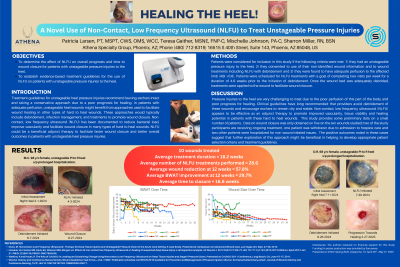Case Series/Study
(CS-080) Novel Use of Non-contact, Low Frequency Ultrasound (NLFU) to Facilitate Healing in Unstageable Pressure Injuries to the Heel
Friday, May 2, 2025
7:45 PM - 8:45 PM East Coast USA Time

Teresa Gaither, MSNE, FNP-C – CO-OWNER, LEAD CLINICIAN, Athena Specialty Group; Mischelle Johnson, PA-C – CO-OWNER, CLINICIAN, Athena Specialty Group; Sharron Miller, RN, BSN – Director of Nursing, Athena Specialty Group
Introduction: Treatment guidelines for unstageable heel pressure recommend leaving eschars intact and taking a conservative approach due to a poor prognosis for healing. In patients with adequate perfusion, unstageable heel wounds might benefit from approaches used to facilitate wound healing in other types of hard to heal wounds. These approaches would typically include debridement, infection management, and treatments to promote wound closure. Non-contact, low frequency ultrasound (NLFU) has been documented to reduce bacterial load, improve vascularity and facilitate wound closure in many types of hard to heal wounds. NLFU could be a beneficial adjunct therapy to facilitate faster wound closure and better overall outcomes in patients with unstageable heel pressure injuries.
Methods: Patients were considered for inclusion in this study If the following criteria were met: 1) they had an unstageable pressure injury to the heel, 2) they consented to use of their non-identified wound information and to wound treatments including NLFU and debridement and 3) they were found to have adequate perfusion to the affected limb (ABI >0.6). Patients were scheduled for NLFU treatments with a goal of completing two visits per week for a duration of 4-6 weeks prior to the initiation of debridement. Once the wound bed was adequately debrided, treatments were applied to the wound to facilitate wound closure.
Results: Ten patients with unstageable heel pressure injuries were evaluated and treated using this model. Four of the ten patients achieved wound closure and six are still undergoing treatment. The four patients who achieved wound closure had an average treatment duration of 15.5 weeks with an average of 18.75 NLFU treatments. The patients currently undergoing treatment have achieved an average wound reduction of 47.4% over an average of 4.8 weeks with an average of 9.6 NLFU treatments.
Discussion: Pressure injuries to the heel are very challenging to treat due to the poor perfusion of this part of the body and poor prognosis for healing. Clinical guidelines have long recommended that providers avoid debridement of these wounds and encourage eschars to remain dry and stable. Non-thermal, low frequency ultrasound (NLFU) appears to be effective as an adjunct therapy to promote improved vascularity, tissue viability and healing potential in patients with these hard to heal wounds. The positive outcomes noted in these cases suggest that further exploration of this approach might be beneficial in helping to develop appropriate patient selection criteria and treatment guidelines.
Methods: Patients were considered for inclusion in this study If the following criteria were met: 1) they had an unstageable pressure injury to the heel, 2) they consented to use of their non-identified wound information and to wound treatments including NLFU and debridement and 3) they were found to have adequate perfusion to the affected limb (ABI >0.6). Patients were scheduled for NLFU treatments with a goal of completing two visits per week for a duration of 4-6 weeks prior to the initiation of debridement. Once the wound bed was adequately debrided, treatments were applied to the wound to facilitate wound closure.
Results: Ten patients with unstageable heel pressure injuries were evaluated and treated using this model. Four of the ten patients achieved wound closure and six are still undergoing treatment. The four patients who achieved wound closure had an average treatment duration of 15.5 weeks with an average of 18.75 NLFU treatments. The patients currently undergoing treatment have achieved an average wound reduction of 47.4% over an average of 4.8 weeks with an average of 9.6 NLFU treatments.
Discussion: Pressure injuries to the heel are very challenging to treat due to the poor perfusion of this part of the body and poor prognosis for healing. Clinical guidelines have long recommended that providers avoid debridement of these wounds and encourage eschars to remain dry and stable. Non-thermal, low frequency ultrasound (NLFU) appears to be effective as an adjunct therapy to promote improved vascularity, tissue viability and healing potential in patients with these hard to heal wounds. The positive outcomes noted in these cases suggest that further exploration of this approach might be beneficial in helping to develop appropriate patient selection criteria and treatment guidelines.

.jpg)